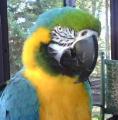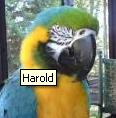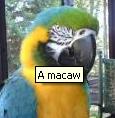 Start sending me some questions, and after a while, I'll see which ones are frequently asked. In the meantime, I've made up a few of my own. That's the way everyone does it anyway. Frequently Asked Questions: Q: What's the best way to follow this blog?
Q: What's the best way to follow this blog? A: You can start at Blog home to see what's new. But while I'm still adding to the blog, a better way may be to start at the beginning, and read the entries in the order in which they were posted, using the Blog index. When you leave and come back, return to the Blog index, scroll down to where you last left off, and click on the next entry. At the bottom, click on Next in blog to keep reading more entries (if there are any). If you want to get an e-mail notification each time I post a new blog entry, just send me an e-mail message asking to be added to my notification list. You'll only get a message once a week, and you can ask to be taken off the list at any time. Once the blog has been completed, and no more entries are being added, it might be better to use the Memoirs index, which will give you the entries in a more or less chronological order in my life (with all the essays at the end). But it's not a great index to use while the blog is still growing, because new entries will pop up in random places, and it will be hard to keep track of what you've already seen and what you haven't. Another way to read the blog, if you want to read all the entries on a particular topic of interest, is to use the Keyword list, which can be reached via a link at the bottom of any index or help page. A blog entry may have one or more "keywords", which identify certain common themes in my writing. These are written in capital letters, and preceeded by an asterisk, e.g. *TECHNOLOGY. If you find you want to peruse all the stories with a particular keyword, go to the Keyword list, and click on the desired keyword. This will take you to the first entry (in blog order) tagged with that keyword. Then, at the bottom of that entry, click on the same keyword. This will take you to the next entry tagged with that keyword. Continue in this manner until you get to a screen telling you there are no more. Be sure to always click on the same keyword each time, not a different one. Back to top Q: Are these pages public? A: Yes, because they are on a public web site where anyone with the URL ("Uniform Resource Locator", the web address) can access them. On February 18, 2010, I added a link to these pages from my "home page", so that they were eventually seen by search engines (because my home page turns up in searches). The blog pages were located by the search engine "Bing" as of March 3, 2010, and by the search engine "Google" ten days later. Curiously, as of March 10, 2010, the blog didn't show up in Google searches even though Google had cached the version of my home page containing a pointer to the blog. So Google must update its cached version of pages that it indexes without necessarily crawling all the links they contain until later (in this case, three days later). Back to top Q: Why aren't you using a commercial blogging web site? A: That would have made setting up these pages a lot easier. But if you read my entry "Introduction: What are these pages?", you'll see that I hope that my writing can be preserved by my family for a long time. Hence, I'm only using a simple version of HTML (the Hyper-Text Markup Language, used for writing web page) and .jpg picture files (see also "Why write using the HTML and JPG file formats?"). I don't want my writing to in any way be at the mercy of some commercial blogging site, which might cease to exist at some point in the future. Back to top Q: Is there any place on the blog to comment on entries? A: No. Although most blogs that use commercial blogging web sites do allow an ability to comment, my site does not. I'm on the board of directors of the Wayland eNews, and from my experience there, it seems to me that allowing comments would drag me into the role of being a moderator, which I don't want to do. What I'm doing, ultimately, is writing a book of memoirs. You can, though, send me an e-mail message. I will read it, and I'll probably even reply. Back to top Q: Can I get E-mail reminders? A: Yes. Write me to request a weekly e–mail notification of new entries (typically every Thursday evening). Your e-mail address will be used for no other purpose, and will not be given to anyone. That also means that the notifications are sent "blind", so that your e-mail address is not exposed to anyone else on the list. Q: Do you ever update an entry after it's been posted? A: Yes. I'll sometimes update an entry to fix typos, correct erroneous statements (my memory isn't what it used to be), add new information, and to add links to other subsequent entries. I don't generally do anything to particularly call attention to these updates, because they don't usually change the basic message of the entry. But most entries have a note at the bottom telling when they were first posted and last updated. What I try to never do is to move an entry. If you bookmark an entry, it should always be in the same place. I don't want to ever re-arrange my files, making old bookmarks invalid. Back to top Q: Do you have other web pages? A: Yes. My regular Home Page has been growing helter-skelter since at least 1999 (I can't remember exactly when I first posted it). But I consider my blog/memoirs to be a separate, self-contained set of pages. They are actually located on a subset of my earlier pages, in sub-directory /LJK. It is the only sub-directory I have with capital letters in the name, and, unlike e-mail addresses, directory names are case-sensitive. so if you ever manually type in the URL of the blog, be sure to type the "LJK" part in upper-case. Some stories on my "old" pages may ultimately be copied into the blog, because they should be part of my memoirs. Back to top Q: Why don't you move your punctuation inside quotes? A: See my "Conventions" page. Back to top Q: Why do some of your images have the same ALT and TITLE text?
But why, if the image is being displayed, would you see the "ALT" text? The HTML specification clearly states that it is only supposed to be seen if the image cannot be shown. The reason you might see the "ALT" text is that the most commonly used browser, Microsoft Internet Explorer, ignored the specification, and displayed the "ALT" text as a tool-tip, up through version 7. This bug was finally corrected in version 8 of Internet Explorer, released in March of 2009. Since I had gotten used to the behavior of Explorer version 7, I took to putting the "tool-tips" text into both the ALT and TITLE attributes, to be sure it would show up regardless of which browser the reader was using. However, as the older browsers start to drop out of use, I'll transition in the future to proper usage of the ALT attribute: to give a good description of the image for people who can't see it. Perhaps a good approach to take is to start the ALT text with the TITLE text, and then add additional explanatory information for people who actually can't see the image. Back to top   |
 A: Did someone really ask that? Images on web pages generally have two text attributes called "ALT" and "TITLE". According to the HTML specification, the "ALT" (alternate) text is supposed to be displayed by the browser if, for some reason, it is unable to display the actual image. Perhaps, for example, the "viewer" of the page is blind, and is using a screen-reader which can read text, but of course can't show images. On the other hand, the "TITLE" text is the title of the image, and should be displayed by the browser in a yellow "tool-tip" box if the mouse is used to move the cursor arrow over the image. The image to the left is created by the following image tag:
A: Did someone really ask that? Images on web pages generally have two text attributes called "ALT" and "TITLE". According to the HTML specification, the "ALT" (alternate) text is supposed to be displayed by the browser if, for some reason, it is unable to display the actual image. Perhaps, for example, the "viewer" of the page is blind, and is using a screen-reader which can read text, but of course can't show images. On the other hand, the "TITLE" text is the title of the image, and should be displayed by the browser in a yellow "tool-tip" box if the mouse is used to move the cursor arrow over the image. The image to the left is created by the following image tag:

 Try hovering your mouse's arrow over the image above. If the yellow "tool-tips" box looks roughly like the one shown to the left, you're seeing the "TITLE" text (correct). If it looks like the one shown to the right, you're seeing the "ALT" text (wrong). The images to the left and right don't show the arrow for technical reasons.
Try hovering your mouse's arrow over the image above. If the yellow "tool-tips" box looks roughly like the one shown to the left, you're seeing the "TITLE" text (correct). If it looks like the one shown to the right, you're seeing the "ALT" text (wrong). The images to the left and right don't show the arrow for technical reasons.